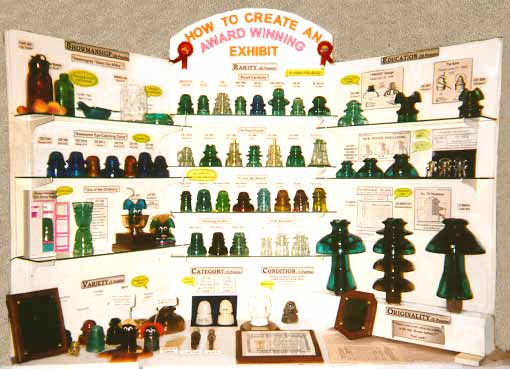Awards
 National Insulator Association Best of General
National Insulator Association Best of General
 Milholland Educational Award
Milholland Educational Award
 Bob & Phoebe Adams Showmanship Award
Bob & Phoebe Adams Showmanship Award
 Triple Ridge Insulator Club, Best Exhibit using Denver Glass
Triple Ridge Insulator Club, Best Exhibit using Denver Glass
|
The National Insulator Association Exhibit and Judging Rules can be found in Section IV - Judging Information, item 9, in the NIA Members Handbook. If you follow the rules, you can be a winner. This display brought to life the point system and criteria for constructing an award winning exhibit. And it was! Not only can the information gained from this be helpful to those who display, it might also be a quick course on how to judge a display as well.
| The NIA Judging system: |
| 30 | Showmanship |
| 30 | Education |
| 30 | Rarity |
| 5 | Variety |
| 5 | Originality |
| Deductions: |
| -5 | Condition |
| -5 | Category non-adherence |
General Tips for Exhibiting: (exhibit handout)
- Build the exhibit around the pieces you want to display, rather than picking pieces to fit into the display. Plan your exhibit lighting. Dependence on the lighting in a show hall could lead to unanticipated problems.
- Make sure your exhibit will be transportable.
- Be sure you can completely set up your display in the time allocated for pre-show set up.
- Be aware of any size and weight constraints ahead of time. Know the size of the exhibit space/table you will be using. Know whether your shelves will handle your heavy power pieces without bending or breaking!
- It is a good idea to create your exhibit "props' with reusability in mind.
- Know the category in which you'll be displaying
- Choose a theme that ties the exhibit together. The theme should be well-integrated throughout the display.
- Set up the exhibit at home as much as you can. Be sure you are viewing it from the same angle that it will be viewed from at the show. Find out your problems before you get stuck! Experiment with different layouts of insulators for pleasing color and size distribution. If the layout is important to the display (it generally is!), make a record of it so you can reconstruct the arrangement. Don't rely on your memory! Pack the insulators in order when possible to make it easier to set up at the show.
- Show your exhibit at local shows before hitting the big time at a National. Getting feedback from knowledgeable people can help you make improvements to earn a better score.
- Read and understand how your exhibit will be judged.
|
